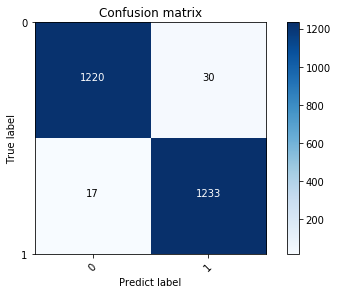keras提供了多种ImageNet预训练模型,前面的文章都采用resnet50,这里改用Xception预训练模型进行迁移学习。
import os from keras import layers,models,optimizers from keras.applications.xception import Xception,preprocess_input from keras.layers import * from keras.models import Model
定义模型:
base_model = Xception(weights='imagenet', include_top=False, input_shape=(150, 150, 3)) x = base_model.output x = GlobalAveragePooling2D()(x) x = Dense(1024)(x) x = BatchNormalization()(x) x = Activation('relu')(x) x = Dropout(0.2)(x) x = Dense(256)(x) x = BatchNormalization()(x) x = Activation('relu')(x) x = Dropout(0.2)(x) predictions = Dense(1, activation='sigmoid')(x) model = Model(inputs=base_model.input, outputs=predictions) optimizer = optimizers.RMSprop(lr=1e-4) def get_lr_metric(optimizer): def lr(y_true, y_pred): return optimizer.lr return lr lr_metric = get_lr_metric(optimizer) model.compile(loss='binary_crossentropy', optimizer=optimizer, metrics=['acc',lr_metric])
准备训练数据:
from keras.preprocessing.image import ImageDataGenerator batch_size = 64 train_datagen = ImageDataGenerator( rotation_range=90, width_shift_range=0.2, height_shift_range=0.2, shear_range=0.2, zoom_range=0.2, horizontal_flip=True, vertical_flip=True, preprocessing_function=preprocess_input) test_datagen = ImageDataGenerator(preprocessing_function=preprocess_input) train_generator = train_datagen.flow_from_directory( # This is the target directory train_dir, # All images will be resized to 150x150 target_size=(150, 150), batch_size=batch_size, # Since we use binary_crossentropy loss, we need binary labels class_mode='binary') validation_generator = test_datagen.flow_from_directory( validation_dir, target_size=(150, 150), batch_size=batch_size, class_mode='binary')
训练模型:
from keras.callbacks import ReduceLROnPlateau,EarlyStopping early_stop = EarlyStopping(monitor='val_loss', patience=13) reduce_lr = ReduceLROnPlateau(monitor='val_loss', patience=7, mode='auto', factor=0.2) callbacks = [early_stop,reduce_lr] history = model.fit_generator( train_generator, steps_per_epoch=train_generator.samples//batch_size, epochs=100, validation_data=validation_generator, validation_steps=validation_generator.samples//batch_size, callbacks=callbacks)
训练32轮后提前结束:
Epoch 1/100 281/281 [==============================] - 152s 542ms/step - loss: 0.2750 - acc: 0.8793 - lr: 1.0000e-04 - val_loss: 0.1026 - val_acc: 0.9665 - val_lr: 1.0000e-04 Epoch 2/100 281/281 [==============================] - 144s 513ms/step - loss: 0.1547 - acc: 0.9388 - lr: 1.0000e-04 - val_loss: 0.1355 - val_acc: 0.9673 - val_lr: 1.0000e-04 Epoch 3/100 281/281 [==============================] - 143s 510ms/step - loss: 0.1204 - acc: 0.9531 - lr: 1.0000e-04 - val_loss: 0.0791 - val_acc: 0.9788 - val_lr: 1.0000e-04
......
Epoch 30/100 281/281 [==============================] - 142s 504ms/step - loss: 0.0103 - acc: 0.9964 - lr: 4.0000e-06 - val_loss: 0.0702 - val_acc: 0.9842 - val_lr: 4.0000e-06 Epoch 31/100 281/281 [==============================] - 141s 503ms/step - loss: 0.0111 - acc: 0.9961 - lr: 4.0000e-06 - val_loss: 0.0667 - val_acc: 0.9842 - val_lr: 4.0000e-06 Epoch 32/100 281/281 [==============================] - 142s 504ms/step - loss: 0.0123 - acc: 0.9954 - lr: 4.0000e-06 - val_loss: 0.0710 - val_acc: 0.9847 - val_lr: 4.0000e-06
测试数据也要进行preprocess_input处理:
def get_input_xy(src=[]): pre_x = [] true_y = [] class_indices = {'cat': 0, 'dog': 1} for s in src: input = cv2.imread(s) input = cv2.resize(input, (150, 150)) input = cv2.cvtColor(input, cv2.COLOR_BGR2RGB) pre_x.append(preprocess_input(input)) _, fn = os.path.split(s) y = class_indices.get(fn[:3]) true_y.append(y) pre_x = np.array(pre_x) return pre_x, true_y def plot_sonfusion_matrix(cm, classes, normalize=False, title='Confusion matrix', cmap=plt.cm.Blues): plt.imshow(cm, interpolation='nearest', cmap=cmap) plt.title(title) plt.colorbar() tick_marks = np.arange(len(classes)) print(tick_marks, type(tick_marks)) plt.xticks(tick_marks, classes, rotation=45) plt.yticks([-0.5,1.5], classes) print(cm) ok_num = 0 for k in range(cm.shape[0]): print(cm[k,k]/np.sum(cm[k,:])) ok_num += cm[k,k] print(ok_num/np.sum(cm)) if normalize: cm = cm.astype('float') / cm.sum(axis=1)[:, np.newaxis] thresh = cm.max() / 2.0 for i, j in itertools.product(range(cm.shape[0]), range(cm.shape[1])): plt.text(j, i, cm[i, j], horizontalalignment='center', color='white' if cm[i, j] > thresh else 'black') plt.tight_layout() plt.ylabel('True label') plt.xlabel('Predict label')
测试图片:
dst_path = r'D:BaiduNetdiskDownloadlarge' test_dir = os.path.join(dst_path, 'test') test = os.listdir(test_dir) images = [] # 获取每张图片的地址,并保存在列表images中 for testpath in test: for fn in os.listdir(os.path.join(test_dir, testpath)): if fn.endswith('jpg'): fd = os.path.join(test_dir, testpath, fn) images.append(fd) # 得到规范化图片及true label pre_x, true_y = get_input_xy(images) # 预测 predictions = model.predict(pre_x) pred_y = [1 if predication[0] > 0.5 else 0 for predication in predictions] # pred_y=np.argmax(predictions,axis=1) # 画混淆矩阵 confusion_mat = confusion_matrix(true_y, pred_y) plot_sonfusion_matrix(confusion_mat, classes=range(2))
测试结果为98.1%:
[[1220 30] [ 17 1233]] 0.976 0.9864 0.9812
猫的准确度为97.6%,狗的为98.6%,总的准确度为98.1%。混淆矩阵图:
